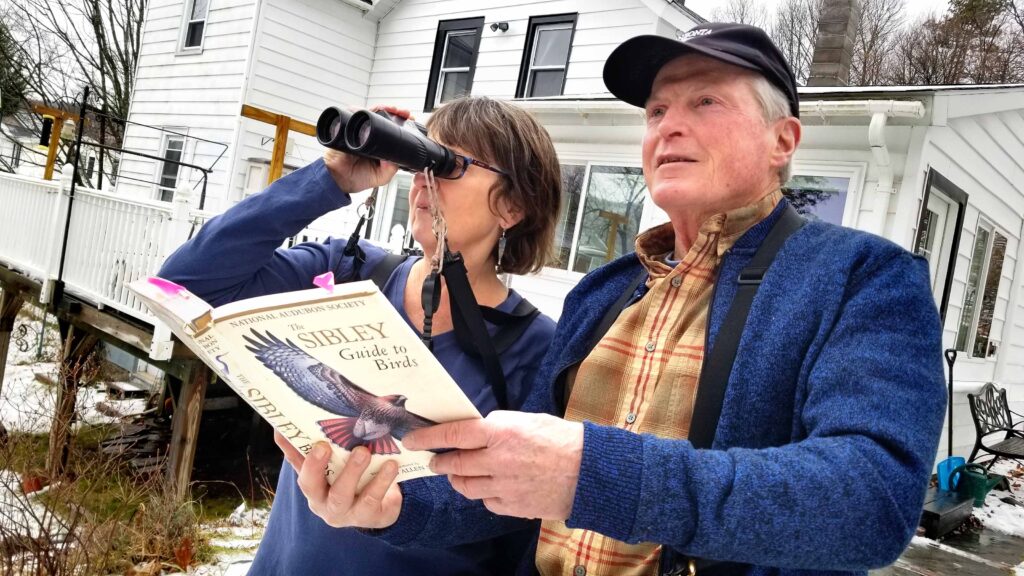Despite All, Birds Flourish
Mother Nature Victorious, Audubon Census ’20 Says
By CHRYSTAL SAVAGE • Special to www.AllOTSEGO.com

The year was 1889, the day was Dec. 25. In many rural parts of the nation, the festive “Christmas Side Hunt” was underway, where – according to one description – “armed participants wandered the countryside shooting at every bird and small animal they saw.”Concerned about the toll on the bird population, a year later American ornithologist Frank Chapman of New York City attempted to undo this now-infamous tradition by replacing it with the Christmas Bird Count.
Since 1970, the Delaware Otsego Audubon Society (DOAS) has participated in the new tradition. This year, as usual, there were three counts: Dec. 19 in Oneonta, Dec. 26 in the Mohawk Valley and, finally, Jan. 2 in Delaware County.
Because of COVID-19, the DOAS discouraged new participants during this year’s Christmas Bird Count. “We’re dealing with a high-risk population,”
DOAS co-President Susan O’Handley, Hartwick, said of the bird-counters. “Many of our birders are elderly, which has guided many of our decisions.”
Still, there are a number of records set within the Oneonta circle. For instance:
Blue jays, with 546 upsetting the previous high of 500 in 1970.
Carolina wrens and dark-eyed juncos, with more juncos spotted than any other species.
Winter wrens, which tied their highest recorded 2019 count.
Fox sparrows and red crossbills, spotted for the first time in a number of years.

This year in the Oneonta count, 4,500 birds were spotted, compared to the average 4,600 birds. And 52 species were spotted, compared to the 41.8 average.
That could have been because it was a nice day, compared to a stormy one the year before, said Sandy Bright, Oneonta, DOAS count coordinator.
The second DOAS co-president, Andy Mason, didn’t notice the day was that different from the year before, and suggested weather and food availability in Canada may have encouraged more birds to fly into this area.
The third and final DOAS co-president, Becky Gretton of Springfield, had another take.
“Normally we go out with our birding buddies,” she said. “However, this year, due to the coronavirus, we were divided up more.”
That resulted in 11 teams of 16 individuals each, instead of the usual larger nine teams. The teams didn’t have to move as quickly from one location
to another, giving them more time to record birds at each stop.
This allowed the teams to be more relaxed and more thorough, said Gretton, allowing care to ensure the same bird wasn’t counted more than once.
Each count occurs within a 7.5-mile radius, DOAS Treasurer Charles Scheim of Oneonta wrote in “Christmas Bird Counts”, published in a 2012 edition of The Belted Kingfisher, the DOAS publication.
“One might think that the experience of birding each of our assigned areas would be very similar. They are, after all, separated by a mere 25 miles, as the crow flies,” he wrote. “But geographical features can make a world of difference in attracting different species.
“There is no expectation that a team will find all the birds in an area, or even count all that can be found: many quiet woodland species may go uncounted; large flocks of geese or buntings can only be estimated.”
Nonetheless, the counts are consistently performed at the same time of the year, year after year, to maintain some standard.
Despite the inability to host in-person events, Mason, O’Handley and Gretton encouraged anyone interested to join the DOAS and help contribute to science.
“The organization goes beyond birds,” Mason explained. Our focus is really on general conservation.
Added O’Handley, “We look to introduce and promote policy that benefits wildlife and their habitats, often that coincides with improved human health as well.” Among the issues – the elimination of lead ammo, carbon reductions, protecting and preserving natural resources and more.
“As issues come up, we move to address them in a way that’s beneficial to nature and hopefully to humans as well;” Gretton added. “We look to build our connection with nature and it is a shared source of interest for the members of the chapter.
Scheim concludes his DOAS piece in posing a poignant question, “Why should anyone forego the comforts of home, perhaps by a fire with a hot beverage, to spend a day enduring freezing temperatures, biting winds, or possibly worse, just to count birds?
“The answer is this: it’s all part of the tradition” – a new tradition of course that seeks to preserve nature instead of destroying it.
The chapter currently has approximately 250 members. If you or someone you know has an interest in joining or participating in any of the upcoming self-guided or virtual events, please visit doas.us

